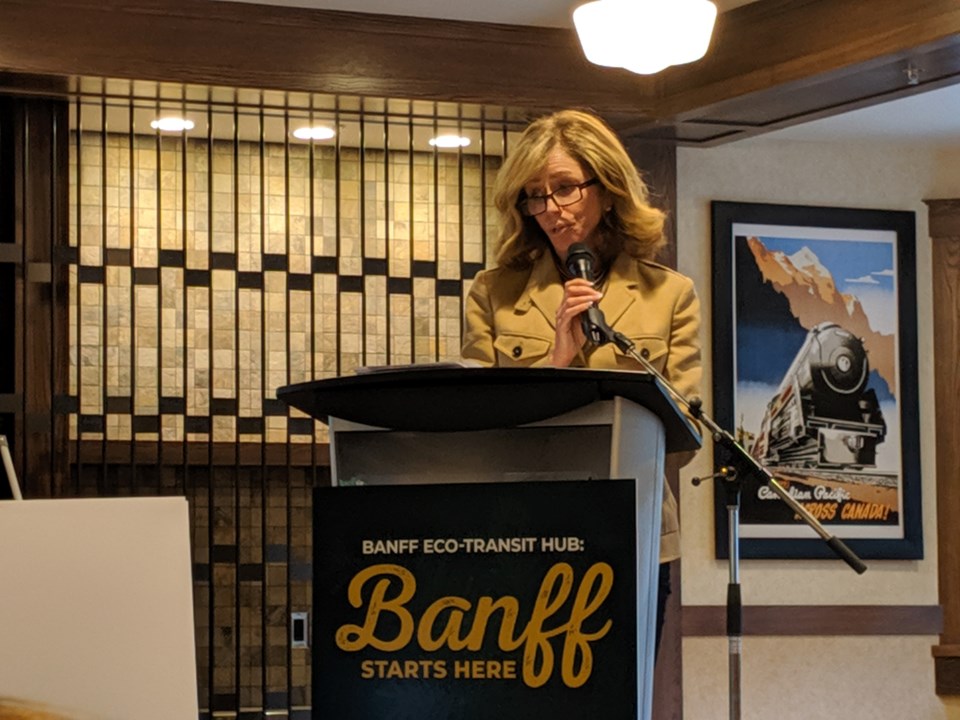BANFF – Banff is one step closer to the possibility of a car-free future, as Liricon Capitol presented some of its contracted research on the economical and ecological impacts of a transit hub concept.
New intercept parking, a passenger rail service from Banff to the Calgary International Airport and a gondola to Mt. Norquay have strong public support according to research conducted by sustainable tourism researcher and Mount Royal University professor Joe Pavelka.
“We carried out a nation-wide poll focusing on Alberta and the rest of Canada, that was a combination of telephone and online. We had just over 1,300 respondents in Alberta … We had 1,400 respondents in the rest of Canada,” said Pavelka, adding roughly 400 were surveyed in Banff itself.
“There is good agreement that first off Banff needs to mind is ecological integrity among all Canadians and that it needs to balance essentially human use and ecological integrity.”
Pavelka presented his findings at the Banff Train Station Friday (Sept. 13) morning and said the public engagement study shows 87 per cent of Banff residents agree that the Town has a congestion issue, with 91 per cent of residents agreeing a more comprehensive plan to mitigate congestion is needed.
Liricon Capitol owners Jan and Adam Waterous, who asked Banff council earlier this year to consider implementing a resident-only vehicle pass as part of the big picture plan to create the transit hub at the train station, said they would also add an intercept parking lot should the gondola be approved. Liricon has full ownership of Mount Norquay ski hill and has acquired leases from Canadian Pacific Railway for the heritage train station and surrounding lands both north and south of the train tracks.
“Should certain mitigations be put in place, aerial transit to Norquay has the potential to enhance the ecological integrity of the Cascade Wildlife Corridor. Secondly, aerial transit provides not just environmental sustainability, but also economic sustainability for the broader project,” said Jan.
“It provides a revenue stream that helps to support other aspects of the eco-transit hub, including the construction of additional 2,000 intercept parking stalls on the north side and with this additional parking capacity, which to be transformational must be offered for free… Aerial transit provides the opportunity to de-privatise 2,500 parking stalls and open up a range of possibilities for visitor and vehicle management for the park.”
Liricon is offering to provide these parking stalls to the Town of Banff for 30 years for free.
Tracy Lee, senior project manager at Miistakis Insitute, a not-for-profit environmental research institute contracted by Liricon, presented research on the impacts of a gondola to the Mt. Norquay summit, which would pass through the Cascade Wildlife Corridor.
“We were tasked with the question of answering: can the Norquay development proposal result in environmental gain to large animals in the Cascade Corridor?” said Lee.
Lee said the Norquay access road passes through the corridor, which research shows to be one of the more active wildlife areas around the townsite. The proposed gondola would mean limited use, or even the decommissioning of the access road, Lee said, which would improve wildlife use and safety. These areas are believed to be frequently accessed by bears, elk, wolves, cougars and bighorn sheep, according to Parks Canada research.
“We had an expert workshop, we did imperical modelling from data from Parks Canada and we had a second expert workshop where we took people through a structured process to weigh different management options,” Lee said.
“We three conservation challenges that we were told are most important: grizzly bear habitat use on the Norquay lease site during the summer and movement through the area, wolf and cougar movement through the area and bighorn sheep lambing.”
Lee said the findings showed if a gondola were to be developed, restricting vehicle use or even decommissioning the Norquay access road, wildlife connectivity of the corridor would be improved. However, Lee said in terms of bighorn sheep lambing, more research has to be done, as they aren’t quite sure where the animals lamb.
Banff Mayor Karen Sorensen was also at Friday morning’s press conference and said the transit hub concept is still in its very early stages.
“We know all of us here, and certainly council, that there are a number of milestones ahead, such as the preparation of a proposal for this entire site,” said Sorensen.
“Council will be reviewing an area redevelopment plan once all of these necessary assessments and draft plans are completed. However, today we are celebrating how far this project has come already.”
Liricon recently opened a free parking lot near the entrance of the Town of Banff. Since its opening at the end of August, Sorensen said the Town has already seen improvement in its traffic congestion.
“I can confidently say it is already successful, just a few numbers combined on Saturday and Sunday of the long weekend – the Town reported 57,000 vehicle movements at our two entrances combined,” she said.
“How we measure things – on those same two days we saw a drop in the number of vehicles going over the bridge… So that means that people were parking or walking, or taking transit.”
Visit www.banff.ca to view the Liricon Capitol and Visitor Management Proposal.


